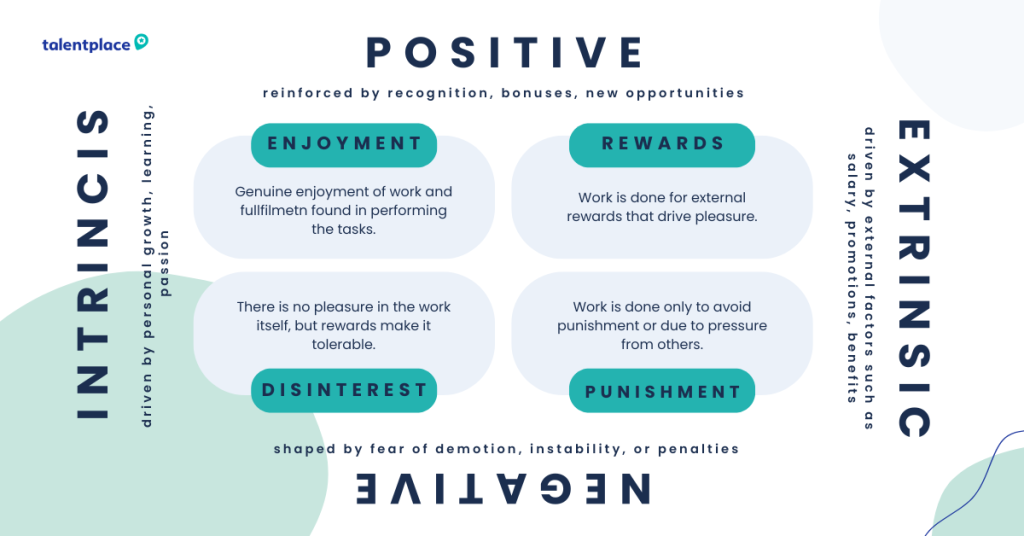You meet a candidate who looks like the perfect fit. They have the right skills, relevant experience, even good chemistry during the call. But a few weeks later, they drop out of the process. Or worse, they accept the job only to resign after a short time.
What went wrong? Most often, it comes down to candidate motivation.
Understanding why someone wants to change jobs and what they expect from their next role is just as important as checking if they can do the job. If the offer doesn’t align with their needs, the match won’t last.
So, how do you get to the bottom of what truly drives a candidate? How can recruiters study candidate needs and motivation and use motivation-based interviewing in practice? Let’s break it down.
The Importance of Motivation in Hiring and Retention
Motivation isn’t just a vague concept. It’s what makes a candidate pick up your call, attend the interview, and eventually accept (or reject) an offer.
Motivation drives:
- Job change decisions (why the candidate is open to leaving their current employer)
- Engagement (how much effort they’ll put into the role)
- Retention (whether they’ll stay long-term)
From a recruiter’s perspective, knowing a candidate’s needs and motivation helps you position the role in the right way, build trust in conversations, and increase the chance of a long-term placement.
| The Link Between Motivation and Job PerformanceResearch shows that motivated employees are:43% more productive (Gallup).68% less likely to leave their employer when their needs are met (SHRM).More creative, resilient, and proactive in the workplace.This means that understanding motivators can help predict future job performance more accurately than qualifications alone. |
Candidate Needs in Recruitment: What Recruiters Should Know
Candidate needs are at the heart of every job search, but they don’t look the same for everyone.
Some candidates are motivated by a higher salary or a more secure contract. Others put flexibility, work-life balance, or opportunities to grow their skills at the top of the list. For some, the deciding factor is values: they want to join a company that reflects what they believe in.
Frameworks like Maslow’s Hierarchy of Needs, Herzberg’s Two-Factor Theory, or Self-Determination Theory can help recruiters make sense of these differences.
Candidate Needs in Maslow’s Hierarchy
- Security – contract type, pay, job stability
- Safety – benefits, work schedule, predictable environment
- Belonging – team culture, supportive managers, collaboration
- Recognition – promotions, raises, being valued for contributions
- Self-development – training, meaningful projects, career growth
But theory only takes you so far. What really matters in practice is understanding which of these needs matter most to the individual sitting across from you.
Mismatches happen when recruiters assume all candidates value the same things. A candidate who cares about career growth won’t stay engaged in a role that offers only stability, no matter how competitive the salary is.
Exploring motivations early in the process is the only way to avoid that situation.
The Different Types of Candidate Motivation Explained

1. Intrinsic Motivation
Intrinsic motivation, like the name suggests, comes from within. It’s driven by personal satisfaction, curiosity, or passion for the work itself. Candidates motivated this way aren’t just looking for a paycheck; they want meaningful challenges and opportunities to grow.
Examples in recruitment:
- A developer applying for a role because they love solving complex coding problems.
- A teacher staying in education because of the fulfillment of helping students succeed.
Recruiter Tip: Highlight learning opportunities, autonomy, and purpose-driven aspects of the role when engaging intrinsically motivated candidates.
2. Extrinsic Motivation
Extrinsic motivation is fueled by external rewards (salary, bonuses, promotions, recognition, or job titles) or penalties (unemployment, negative feedback, etc.). While often seen as “less authentic,” it’s still a powerful driver in career decision-making.
Examples in recruitment:
- A sales professional motivated by commission and performance-based bonuses.
- A manager seeking a promotion to gain status and recognition.
Recruiter Tip: Be transparent about compensation, benefits, and career progression paths when speaking to extrinsically motivated candidates.
3. Positive Motivation
Positive motivation is about moving towards something desirable—growth, recognition, or rewards. Candidates with positive motivation see challenges as opportunities and are more likely to thrive in dynamic, evolving workplaces.
Examples in recruitment:
- A marketer excited to join a startup because of the chance to build a brand from scratch.
- An engineer motivated by the possibility of leading a new product launch.
Recruiter Tip: Frame opportunities in terms of gains such as new skills, achievements, or recognition.
4. Negative Motivation
Negative motivation stems from the desire to avoid negative consequences, such as job insecurity, demotion, or poor work environments. While effective in the short term, it can lead to disengagement if the underlying fears aren’t addressed.
Examples in recruitment:
- An employee leaving a toxic workplace for a role that offers stability and respect.
- A candidate accepting a job mainly to avoid unemployment.
Recruiter Tip: Dig deeper. Negative motivation may mask real motivators like security, recognition, or growth. Make sure that the new role genuinely resolves these concerns.
Motivation-Based Interviewing: Strategies Recruiters Can Use
Once you understand the theory behind candidate motivation, the next step is turning it into practice. Recruiters need tools and methods that help reveal not just what a candidate says they want, but what truly drives their decisions.
Behavioral Interviews and Open-Ended Questions
This is where motivation-based interviewing comes in. Instead of focusing only on skills, it digs into past experiences, choices, and patterns. Asking candidates about how they made decisions in their careers and what kept them engaged or disengaged can reveal their motivators.
The key is to use open-ended questions. These encourage candidates to talk freely, moving beyond rehearsed answers. They also create space for uncovering intrinsic motivators like curiosity, purpose, or a drive to learn.
Examples of Open-Ended Recruiter Questions
Here are practical recruiter questions you can add to your interviews:
- “What do you look for when choosing a new job?”
- “How do you prefer to work: independently or in a team?”
- “What makes you feel fulfilled in your job?”
- “What’s most important for you in a manager or team?”
- “What career goals have you set for yourself this year?”
- “What helps you stay motivated day-to-day?”
- “What was your greatest professional success, and what motivated you to achieve it?”
- “How do you handle stress or setbacks at work?”
These questions do two things: they help you assess candidate needs and they signal to the candidate that you’re listening and interested in what matters to them, not just in filling a vacancy.
Psychometric and Motivation Assessment Tests
Tools like motivation questionnaires or personality assessments provide structured insights into what drives a candidate.
For example, SHL Motivation Questionnaire presents statements describing work conditions or behaviors and asks respondents to rate how much each would motivate them. The result is a motivational “map” showing what energizes a person and what might demotivate them.
Another test, the MQ by mySkillsProfile, measures 20 dimensions across three domains: autonomy, relatedness, and competence.
Then there’s OD-Tools’ Motivation Questionnaire, which tracks work-related needs (15 scales), satisfaction levels, and locus of control.
These instruments give you structured data. But the magic happens when you interpret those data in light of the interview, looking for consistency, gaps, or surprises.
Situational Judgment and Case Study Exercises
Sometimes the best way to assess motivation is to see how a candidate reacts in a realistic scenario.
Example: You’re hiring a sales manager. Present a case where revenue targets were missed for two consecutive quarters. Ask how they would respond. Do they focus on motivating the team, introducing new processes, or asking for higher incentives? Their answers reveal more than problem-solving skills. They uncover intrinsic and extrinsic drivers.
A related approach is feed-forward interviewing. Instead of standard questions, you explore moments of genuine achievement:
- “What was your greatest professional success?”
- “What would need to happen for you to achieve similar results again?”
- “What personal attitude or behavior helped you succeed?”
These questions highlight not just what motivates a candidate, but how they translate that motivation into action.
Using AI and Data Analytics in Recruitment Insights
Modern recruitment technology uses AI-driven analytics to spot motivation signals in resumes, interviews, and even social media activity. Combined with human insight, they help recruiters build data-backed motivation profiles.
Examples of tools:
- HireVue: Analyzes video interviews for tone, facial expressions, and word choice.
- Knockri: Uses natural language processing to evaluate candidate answers against behavior-based competencies.
- Canditech: Offers simulations and AI scoring with dashboards for comparing candidates.
These tools don’t replace recruiter judgment, but they surface signals that can be explored in conversation.
Analyzing Career History and Achievements
A candidate’s career history is often the most honest record of their motivation.
- Rapid promotions and responsibility increases may point to ambition and achievement-driven behavior.
- Long tenure in one company may suggest loyalty, preference for stability, or satisfaction with the environment.
- Choice of roles can signal motivators: candidates with team-based roles may value belonging, while those in specialist tracks may prefer autonomy.
Recruiters also need to separate short-term motivators (salary, perks, job titles) from long-term drivers (career growth, purpose, values). The first might trigger a move, but the second sustains motivation over time.
3 Mistakes Recruiters Make When Assessing Candidate Motivation
1. Overlooking Subtle Motivational Cues
It’s easy to focus only on the content of a candidate’s answers. But non-verbal cues such as tone, level of enthusiasm, body language, and consistency in their story often reveal more than words.
A candidate might say they’re motivated by growth, but if they light up only when discussing teamwork, their true driver may be belonging.
2. Relying Too Much on CV and Technical Skills
CVs show what a candidate has done, not why they did it. Two people with identical experience can be motivated by entirely different things. One might be chasing recognition, the other financial stability.
If you rely solely on CVs and skills, you risk missing the deeper motivators that will determine long-term success in the role.
3. Misinterpreting Candidate Aspirations
When candidates talk about “career growth,” it can mean very different things. For some, it’s about moving into leadership. For others, it’s financial advancement, or simply the chance to keep learning.
If recruiters don’t probe far enough, they risk misaligning expectations with the role, leading to disengagement or quick turnover.
From Motivation to Retention: Using Insights for Better Hiring Outcomes
At the end of the day, successful recruitment isn’t just about matching skills to job descriptions. It’s about matching people to opportunities that align with their needs and motivation.
When you understand what drives a candidate, you can:
- Present the role in the right way, highlighting the aspects that matter most to them.
- Build stronger trust with both candidate and client by showing empathy and insight.
- Develop candidate personas (e.g. a typical mid-level developer, marketer, or recruiter) to anticipate common motivators and tailor your approach.
This shift pays off. You reduce mismatches, shorten time-to-hire, and increase retention, all of which translate into higher ROI for recruitment teams and clients.
Recruitment becomes more effective when you move beyond the CV and into what a candidate actually wants from their career. Motivation is the missing link between hiring someone who can do the job and hiring someone who will thrive in it.
Want to make hiring easier? Reach out to Talent Place and find candidates who are not only qualified but motivated to succeed.
FAQ
- What are motivation insights in recruitment?
Motivation insights are techniques and tools used to understand what drives a candidate’s career decisions, job satisfaction, and long-term engagement. - How do recruiters identify candidate motivations?
Through behavioral interviews, motivation assessments, AI-driven analytics, and careful analysis of career history, recruiters can uncover what truly motivates a candidate. - Why is motivation important in hiring?
Motivation directly impacts performance, engagement, and retention. Candidates whose motivations align with company values are more likely to thrive and stay longer. - Can motivation be measured accurately?
While no tool is perfect, psychometric tests, structured interviews, and data-driven methods provide reliable insights when combined with recruiter intuition. - How can employers attract motivated candidates?
By clearly communicating values, offering growth opportunities, and creating a transparent recruitment process, employers can appeal to candidates motivated by both intrinsic and extrinsic factors.

